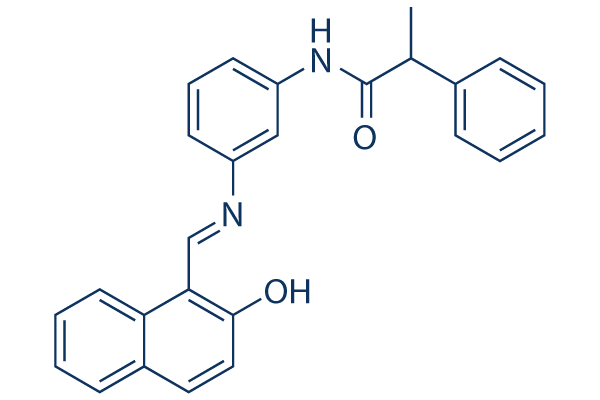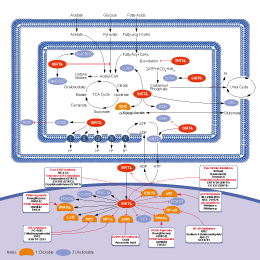
- Bioactive Compounds
- By Signaling Pathways
- PI3K/Akt/mTOR
- Epigenetics
- Methylation
- Immunology & Inflammation
- Protein Tyrosine Kinase
- Angiogenesis
- Apoptosis
- Autophagy
- ER stress & UPR
- JAK/STAT
- MAPK
- Cytoskeletal Signaling
- Cell Cycle
- TGF-beta/Smad
- DNA Damage/DNA Repair
- Compound Libraries
- Popular Compound Libraries
- Customize Library
- Clinical and FDA-approved Related
- Bioactive Compound Libraries
- Inhibitor Related
- Natural Product Related
- Metabolism Related
- Cell Death Related
- By Signaling Pathway
- By Disease
- Anti-infection and Antiviral Related
- Neuronal and Immunology Related
- Fragment and Covalent Related
- FDA-approved Drug Library
- FDA-approved & Passed Phase I Drug Library
- Preclinical/Clinical Compound Library
- Bioactive Compound Library-I
- Bioactive Compound Library-Ⅱ
- Kinase Inhibitor Library
- Express-Pick Library
- Natural Product Library
- Human Endogenous Metabolite Compound Library
- Alkaloid Compound LibraryNew
- Angiogenesis Related compound Library
- Anti-Aging Compound Library
- Anti-alzheimer Disease Compound Library
- Antibiotics compound Library
- Anti-cancer Compound Library
- Anti-cancer Compound Library-Ⅱ
- Anti-cancer Metabolism Compound Library
- Anti-Cardiovascular Disease Compound Library
- Anti-diabetic Compound Library
- Anti-infection Compound Library
- Antioxidant Compound Library
- Anti-parasitic Compound Library
- Antiviral Compound Library
- Apoptosis Compound Library
- Autophagy Compound Library
- Calcium Channel Blocker LibraryNew
- Cambridge Cancer Compound Library
- Carbohydrate Metabolism Compound LibraryNew
- Cell Cycle compound library
- CNS-Penetrant Compound Library
- Covalent Inhibitor Library
- Cytokine Inhibitor LibraryNew
- Cytoskeletal Signaling Pathway Compound Library
- DNA Damage/DNA Repair compound Library
- Drug-like Compound Library
- Endoplasmic Reticulum Stress Compound Library
- Epigenetics Compound Library
- Exosome Secretion Related Compound LibraryNew
- FDA-approved Anticancer Drug LibraryNew
- Ferroptosis Compound Library
- Flavonoid Compound Library
- Fragment Library
- Glutamine Metabolism Compound Library
- Glycolysis Compound Library
- GPCR Compound Library
- Gut Microbial Metabolite Library
- HIF-1 Signaling Pathway Compound Library
- Highly Selective Inhibitor Library
- Histone modification compound library
- HTS Library for Drug Discovery
- Human Hormone Related Compound LibraryNew
- Human Transcription Factor Compound LibraryNew
- Immunology/Inflammation Compound Library
- Inhibitor Library
- Ion Channel Ligand Library
- JAK/STAT compound library
- Lipid Metabolism Compound LibraryNew
- Macrocyclic Compound Library
- MAPK Inhibitor Library
- Medicine Food Homology Compound Library
- Metabolism Compound Library
- Methylation Compound Library
- Mouse Metabolite Compound LibraryNew
- Natural Organic Compound Library
- Neuronal Signaling Compound Library
- NF-κB Signaling Compound Library
- Nucleoside Analogue Library
- Obesity Compound Library
- Oxidative Stress Compound LibraryNew
- Plant Extract Library
- Phenotypic Screening Library
- PI3K/Akt Inhibitor Library
- Protease Inhibitor Library
- Protein-protein Interaction Inhibitor Library
- Pyroptosis Compound Library
- Small Molecule Immuno-Oncology Compound Library
- Mitochondria-Targeted Compound LibraryNew
- Stem Cell Differentiation Compound LibraryNew
- Stem Cell Signaling Compound Library
- Natural Phenol Compound LibraryNew
- Natural Terpenoid Compound LibraryNew
- TGF-beta/Smad compound library
- Traditional Chinese Medicine Library
- Tyrosine Kinase Inhibitor Library
- Ubiquitination Compound Library
-
Cherry Picking
You can personalize your library with chemicals from within Selleck's inventory. Build the right library for your research endeavors by choosing from compounds in all of our available libraries.
Please contact us at info@selleckchem.com to customize your library.
You could select:
- Antibodies
- Bioreagents
- qPCR
- 2x SYBR Green qPCR Master Mix
- 2x SYBR Green qPCR Master Mix(Low ROX)
- 2x SYBR Green qPCR Master Mix(High ROX)
- Protein Assay
- Protein A/G Magnetic Beads for IP
- Anti-Flag magnetic beads
- Anti-Flag Affinity Gel
- Anti-Myc magnetic beads
- Anti-HA magnetic beads
- Poly DYKDDDDK Tag Peptide lyophilized powder
- Protease Inhibitor Cocktail
- Protease Inhibitor Cocktail (EDTA-Free, 100X in DMSO)
- Phosphatase Inhibitor Cocktail (2 Tubes, 100X)
- Cell Biology
- Cell Counting Kit-8 (CCK-8)
- Animal Experiment
- Mouse Direct PCR Kit (For Genotyping)
- New Products
- Contact Us
Salermide
Home DNA Damage/DNA Repair Sirtuin inhibitor Salermide
For research use only.
Salermide is a reverse amide with a strong in vitro inhibitory effect on Sirt1 and Sirt2. Compared with Sirt1, Salermide is even more efficient at inhibiting Sirt2.

Salermide Chemical Structure
CAS No. 1105698-15-4
Purity & Quality Control
Batch:
S846001
DMSO]78 mg/mL]false]Ethanol]8 mg/mL]false]Water]Insoluble]false
Purity:
99.79%
99.79
Salermide Related Products
| Related Targets | SIRT1 SIRT2 SIRT3 SIRT6 SIRT5 | Click to Expand |
|---|---|---|
| Related Products | Selisistat (EX 527) SRT1720 HCl Sirtinol Quercetin Fisetin 3-TYP AGK2 OSS_128167 SRT2104 (GSK2245840) SirReal2 Thiomyristoyl Salvianolic acid B SRT2183 UBCS039 SRT3025 HCl AK 7 Inauhzin NRD167 CAY10602 | Click to Expand |
| Related Compound Libraries | FDA-approved Drug Library Natural Product Library Apoptosis Compound Library DNA Damage/DNA Repair compound Library Cell Cycle compound library | Click to Expand |
Signaling Pathway
Cell Data
| Cell Lines | Assay Type | Concentration | Incubation Time | Formulation | Activity Description | PMID |
|---|---|---|---|---|---|---|
| CRO cells | Cytotoxicity assay | 72 h | Cytotoxicity against human CRO cells after 72 hrs by celltiter-glo luminescent assay, CC50=6.7 μM | |||
| CRC 1.1 cells | Cytotoxicity assay | 72 h | Cytotoxicity against human CRC 1.1 cells after 72 hrs by celltiter-glo luminescent assay, CC50=9.7 μM | |||
| 30PT cells | Cytotoxicity assay | 72 h | Cytotoxicity against human 30PT cells after 72 hrs by celltiter-glo luminescent assay, CC50=36.5 μM | |||
| 30P cells | Cytotoxicity assay | 72 h | Cytotoxicity against human 30P cells after 72 hrs by celltiter-glo luminescent assay, CC50=41 μM | |||
| MCF7 cells | Proliferation assay | 30 μM | 24-72 h | Antiproliferative activity against human MCF7 cells at 30 uM after 24 to 72 hrs | ||
| U937 cells | Function assay | 50 μM | 45 h | Induction of apoptosis in human U937 cells at 50 uM after 45 hrs by flow cytometry | ||
| MOLT4 cells | Proliferation assay | 25 μM | 24-72 h | Antiproliferative activity against human MOLT4 cells at 25 uM after 24 to 72 hrs by MTT assay | ||
| MDA-MB-231 cells | Proliferation assay | 25 μM | 24-72 h | Antiproliferative activity against human MDA-MB-231 cells at 25 uM after 24 to 72 hrs by MTT assay | ||
| RKO cells | Proliferation assay | 25 μM | 24-72 h | Antiproliferative activity against human RKO cells at 25 uM after 24 to 72 hrs by MTT assay | ||
| Click to View More Cell Line Experimental Data | ||||||
Biological Activity
| Description | Salermide is a reverse amide with a strong in vitro inhibitory effect on Sirt1 and Sirt2. Compared with Sirt1, Salermide is even more efficient at inhibiting Sirt2. | ||
|---|---|---|---|
| Targets |
|
| In vitro | ||||
| In vitro | Salermide prompts tumour-specific cell death in a wide range of human cancer cell lines. The antitumour activity of Salermide is primarily because of a massive induction of apoptosis. Salermide induces apoptosis in cancer but not in normal cells. It induces strong apoptosis without any evident effect on the cell cycle in all the cancer cell lines analysed except in non-tumorigenic MRC5 cells. The induction of apoptosis is cell-type-specific and dose-dependent[1]. | |||
|---|---|---|---|---|
| Cell Research | Cell lines | MOLT4, MDA-MB-231 and SW480 cancer cell lines | ||
| Concentrations | 0, 25, 50, 75 or 100 μM | |||
| Incubation Time | 24 h | |||
| Method | Cell viability is determined using the 3-(4,5-dimethylthiazol-2-yl)-2,5-diphenyltetrazolium bromide assay as described earlier. IC50 index is calculated using four Salermide concentrations (25, 50, 75 and 100 μm) for 24 h. The percentage of apoptotic cells is determined with the FACSCalibur apparatus. | |||
| In Vivo | ||
| In vivo | Salermide is well tolerated by mice at concentrations up to 100 μM. Its feeding does not produce any adverse health effects in mice as monitored by diet consumption, body-weight gain, and postural and behavioural changes[1]. | |
|---|---|---|
| Animal Research | Animal Models | Athymic (BALB/c, nu/nu) female nude mice |
| Dosages | 100 μl of 100 μM | |
| Administration | i.p. | |
|
Chemical Information & Solubility
| Molecular Weight | 394.47 | Formula | C26H22N2O2 |
| CAS No. | 1105698-15-4 | SDF | Download Salermide SDF |
| Smiles | CC(C1=CC=CC=C1)C(=O)NC2=CC(=CC=C2)N=CC3=C(C=CC4=CC=CC=C43)O | ||
| Storage (From the date of receipt) | |||
|
In vitro |
DMSO : 78 mg/mL ( (197.73 mM) Moisture-absorbing DMSO reduces solubility. Please use fresh DMSO.) Ethanol : 8 mg/mL Water : Insoluble |
Molecular Weight Calculator |
|
In vivo Add solvents to the product individually and in order. |
In vivo Formulation Calculator |
|||||
Preparing Stock Solutions
Molarity Calculator
In vivo Formulation Calculator (Clear solution)
Step 1: Enter information below (Recommended: An additional animal making an allowance for loss during the experiment)
mg/kg
g
μL
Step 2: Enter the in vivo formulation (This is only the calculator, not formulation. Please contact us first if there is no in vivo formulation at the solubility Section.)
% DMSO
%
% Tween 80
% ddH2O
%DMSO
%
Calculation results:
Working concentration: mg/ml;
Method for preparing DMSO master liquid: mg drug pre-dissolved in μL DMSO ( Master liquid concentration mg/mL, Please contact us first if the concentration exceeds the DMSO solubility of the batch of drug. )
Method for preparing in vivo formulation: Take μL DMSO master liquid, next addμL PEG300, mix and clarify, next addμL Tween 80, mix and clarify, next add μL ddH2O, mix and clarify.
Method for preparing in vivo formulation: Take μL DMSO master liquid, next add μL Corn oil, mix and clarify.
Note: 1. Please make sure the liquid is clear before adding the next solvent.
2. Be sure to add the solvent(s) in order. You must ensure that the solution obtained, in the previous addition, is a clear solution before proceeding to add the next solvent. Physical methods such
as vortex, ultrasound or hot water bath can be used to aid dissolving.
Tech Support
Answers to questions you may have can be found in the inhibitor handling instructions. Topics include how to prepare stock solutions, how to store inhibitors, and issues that need special attention for cell-based assays and animal experiments.
Tel: +1-832-582-8158 Ext:3
If you have any other enquiries, please leave a message.
* Indicates a Required Field






































